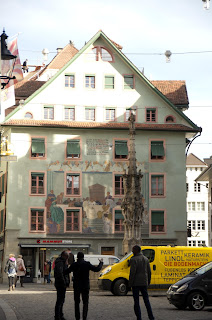Lucerne is a lovely small city in the middle of Switzerland.
We spent four nights there on our way to Basel where we would get on the Viking
Kvasir for our cruise down the Rhine to Amsterdam. Not only is it a fun city on
its own, it is the center of a recreational area that offers just about any
kind of summer or winter activity you could ask for.
The city straddles the Reuss River where it enters Lake
Lucerne in the midst Alps. We were particularly fascinated by the painted
buildings. It seems that the thing to do is paint interesting pictures on the
sides of buildings to make them more attractive. We certainly approve. Actually,
most buildings aren’t painted, but that just makes those that are more
interesting.
Swans, ducks and gulls have made a home of the river no doubt attracted by the tourists and locals who provide plenty of bread.
Swans, ducks and gulls have made a home of the river no doubt attracted by the tourists and locals who provide plenty of bread.
Lucerne sports the most photographed bridge in Switzerland,
a covered bridge crossing the bay. The Chapel Bridge was built in the 14th
century as part of the city’s fortifications. Today it still functions as a
walking bridge joining the two parts of the city. The small tower, added as a
chapel in 1568 today houses a souvenir shop. Inside the bridge itself, 17th
century paintings of scenes from Lucerne’s and Switzerland’s history adorn the ceiling
area. At one time 110 of these paintings covered both sides of the triangular
boards beneath the roof. Unfortunately, most are gone today including several
that were lost in a fire a few years ago. The charred beams still show evidence
of the fire. Still, those that remain add
to the interest of a walk across the bridge.
Lucerne’s other famous site is the Dying Lion of Lucerne.
Carved from the rock face, it commemorates the heroism of the Swiss soldiers
who died attempting to protect the Tuileries Palace during the French
Revolution. Mark Twain called it “the saddest and most moving piece of rock in
the world”.
We are quickly learning that Christmas is a major
undertaking here in Europe. Streets and buildings are decorated. One building
uses its windows as an advent calendar. Each day the shutter opens to reveal a
new Christmas scene. Many towns also have their own Christmas market. The shops
are not housed in tents; the wood constructions ensures a sturdiness in the
winter weather and adds to the Christmas look. Gluwein (milled wine) is served
throughout and each town offers its own collectible mug. The presence of food
and gluwein make the markets a wonderful strolling area for families along with
the tourists.




















No comments:
Post a Comment